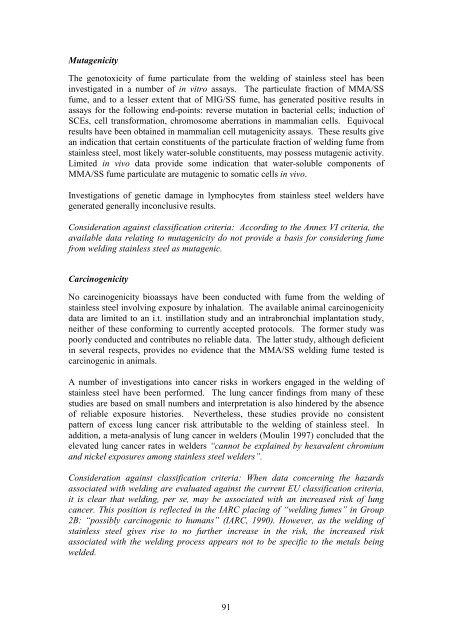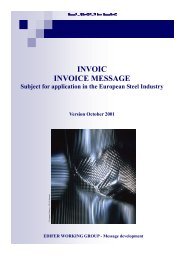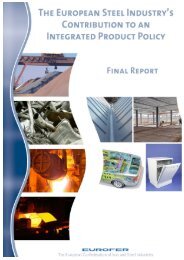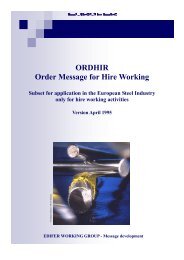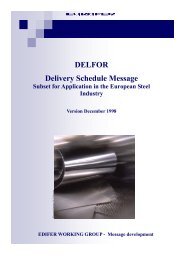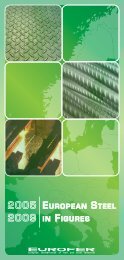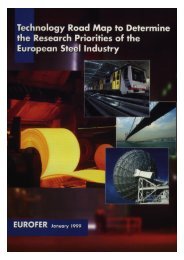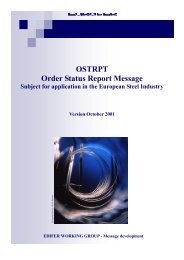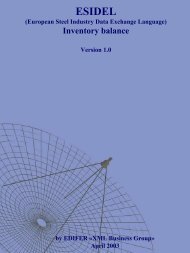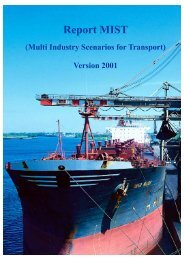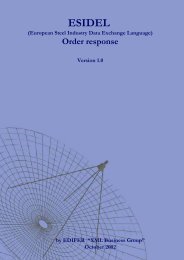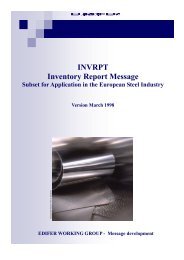manufacture, processing and use of stainless steel - International ...
manufacture, processing and use of stainless steel - International ...
manufacture, processing and use of stainless steel - International ...
Create successful ePaper yourself
Turn your PDF publications into a flip-book with our unique Google optimized e-Paper software.
Mutagenicity<br />
The genotoxicity <strong>of</strong> fume particulate from the welding <strong>of</strong> <strong>stainless</strong> <strong>steel</strong> has been<br />
investigated in a number <strong>of</strong> in vitro assays. The particulate fraction <strong>of</strong> MMA/SS<br />
fume, <strong>and</strong> to a lesser extent that <strong>of</strong> MIG/SS fume, has generated positive results in<br />
assays for the following end-points: reverse mutation in bacterial cells; induction <strong>of</strong><br />
SCEs, cell transformation, chromosome aberrations in mammalian cells. Equivocal<br />
results have been obtained in mammalian cell mutagenicity assays. These results give<br />
an indication that certain constituents <strong>of</strong> the particulate fraction <strong>of</strong> welding fume from<br />
<strong>stainless</strong> <strong>steel</strong>, most likely water-soluble constituents, may possess mutagenic activity.<br />
Limited in vivo data provide some indication that water-soluble components <strong>of</strong><br />
MMA/SS fume particulate are mutagenic to somatic cells in vivo.<br />
Investigations <strong>of</strong> genetic damage in lymphocytes from <strong>stainless</strong> <strong>steel</strong> welders have<br />
generated generally inconclusive results.<br />
Consideration against classification criteria: According to the Annex VI criteria, the<br />
available data relating to mutagenicity do not provide a basis for considering fume<br />
from welding <strong>stainless</strong> <strong>steel</strong> as mutagenic.<br />
Carcinogenicity<br />
No carcinogenicity bioassays have been conducted with fume from the welding <strong>of</strong><br />
<strong>stainless</strong> <strong>steel</strong> involving exposure by inhalation. The available animal carcinogenicity<br />
data are limited to an i.t. instillation study <strong>and</strong> an intrabronchial implantation study,<br />
neither <strong>of</strong> these conforming to currently accepted protocols. The former study was<br />
poorly conducted <strong>and</strong> contributes no reliable data. The latter study, although deficient<br />
in several respects, provides no evidence that the MMA/SS welding fume tested is<br />
carcinogenic in animals.<br />
A number <strong>of</strong> investigations into cancer risks in workers engaged in the welding <strong>of</strong><br />
<strong>stainless</strong> <strong>steel</strong> have been performed. The lung cancer findings from many <strong>of</strong> these<br />
studies are based on small numbers <strong>and</strong> interpretation is also hindered by the absence<br />
<strong>of</strong> reliable exposure histories. Nevertheless, these studies provide no consistent<br />
pattern <strong>of</strong> excess lung cancer risk attributable to the welding <strong>of</strong> <strong>stainless</strong> <strong>steel</strong>. In<br />
addition, a meta-analysis <strong>of</strong> lung cancer in welders (Moulin 1997) concluded that the<br />
elevated lung cancer rates in welders “cannot be explained by hexavalent chromium<br />
<strong>and</strong> nickel exposures among <strong>stainless</strong> <strong>steel</strong> welders”.<br />
Consideration against classification criteria: When data concerning the hazards<br />
associated with welding are evaluated against the current EU classification criteria,<br />
it is clear that welding, per se, may be associated with an increased risk <strong>of</strong> lung<br />
cancer. This position is reflected in the IARC placing <strong>of</strong> “welding fumes” in Group<br />
2B: “possibly carcinogenic to humans” (IARC, 1990). However, as the welding <strong>of</strong><br />
<strong>stainless</strong> <strong>steel</strong> gives rise to no further increase in the risk, the increased risk<br />
associated with the welding process appears not to be specific to the metals being<br />
welded.<br />
91


